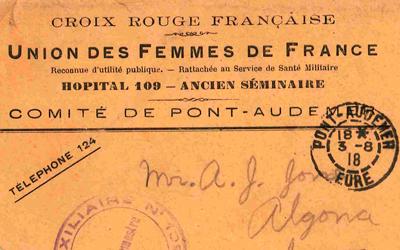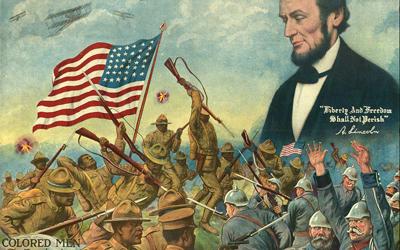Should you fight for a country that is fighting against you?
“Our liberties we prize and our rights we will maintain.” That is the official motto of the state of Iowa. Liberties and rights refer to our freedoms to pursue our own goals, but they must balance those with the rights and liberties of others. Rights and liberties often deal with restrictions on what the government can do, but they also include what we can or cannot do to others.
Rights and Restrictions
Both the federal and state constitutions list specific restrictions on the powers of government. These include the freedom of speech, religion, the press and assembly as well as numerous other guarantees against government intrusion into areas of our private lives. However, who enjoys these rights has been a debate. Questions over race have been an ongoing issue. Early Iowa lawmakers placed restrictions on African-Americans’ right to live here, to vote, to serve on juries or attend school. Gradually, legal restrictions were removed, but African Americans still face hurdles in reaching full equality. The Iowa Supreme Court issued important rulings against slavery and racial discrimination in public education and in public accommodations, like transportation and housing.
The right to vote was originally restricted to white men only, but first African-American men and then all women gained the right. Women’s suffrage was tied politically to the regulation of alcohol with the assumption that women voters would restrict saloons and similar establishments. Those who favored more lenient alcohol laws usually opposed women’s suffrage.
Similar debates have surrounded issues of religion, ethnicity and sexual orientation. In 2009, the Iowa Supreme Court ruled that same-sex couples could marry in Iowa because the constitution says that all citizens must be treated equally. The opinion thrust Iowa into the national spotlight as the state became the fifth to grant the right to same-sex couples. Some religious groups pushed back claiming that the Bible forbids such unions and that churches should not be required to engage in activities that violate to practice their religion. Whose rights are more important?
Catalysts of Change
The expansion of the protection of the law rarely happens without a major political push from the group’s advocates. Granting African-American males the right to vote and removing constitution restrictions limiting certain rights to “whites” only was a major issue in the 1868 election following the Civil War.
Women’s suffrage advocates almost achieved a victory in the early 1870s but the effort spluttered when the U.S. Supreme Court nullified a referendum on a technicality. Iowa-born Carrie Chapman Catt rose to the leadership of a national women’s suffrage organization credited with final passage in Congress submitting the question to the states. The Civil Rights marches in the 1960s had local support in Iowa and were an important political issue. Iowa voters narrowly defeated an Equal Rights Amendment that would have prohibited discrimination based on sex. Three of the seven judges who approved the unanimous Supreme Court decision on same-sex marriage were voted off the bench by a movement led by religious conservatives.
While the trend is to prohibit discrimination against an ever wider circle of citizens, how to balance individual liberties, the common good and the authority of the government remains a source of debate. Through it all, Iowa’s motto remains constant: “Our liberties we prize and our rights we will maintain.”
Supporting Questions
What is the story of the disenfranchised Iowans who contributed to Iowa’s effort during World War I?
- Portrait of Army Private Jonas M. Poweshiek, 1917 (Image)
- Graduates and Teachers from the Tuskegee Institute in Army Training Camp, August 10, 1917 (Image)
- "The History and Views of Colored Officers Training Camp at Fort Des Moines for 1917" Advertisement, September 21, 1917 (Document)
- African-American Captains at Ft. Des Moines, October 15, 1917 (Image)
- World War I YMCA Educational Secretaries, 1918 (Image)
- Portrait of Army Private Robert Young Bear, 1918 (Image)
- Private George Stewart Letter from World War I, August 3, 1918 (Document)
- Letter from Private Estle Senter to his Mother During World War I, December 19, 1918 (Document)
Did their contribution to the war effort influence society’s beliefs about each of these groups of Iowans?
- “Lieut. Hal Short Visits Iowa City" Newspaper Article, December 27, 1917 (Document)
- American Red Cross Rest Room for African-American Soldiers and Sailors, between 1917 and 1919 (Image)
- "True Sons of Freedom" Poster, 1918 (Image)
- 803rd Pioneer Infantry Band on the U.S.S. Philippines, 1919 (Image)
- Women’s Army Corps Company Outside Des Moines Theater, September 29, 1943 (Image)
Did the public support these disenfranchised groups and their contributions to the war effort, or did they continue to treat these groups poorly?
- Letter from W.E.B. Du Bois to U.S. Secretary of War Newton Baker Praising Ft. Des Moines, October 17, 1917 (Document)
- Letter from W.E.B. Du Bois to President Woodrow Wilson, November 1918 (Document)
- Charles Young Auxiliary at Red Cross Bazaar in Des Moines, Iowa, December 20, 1918 (Image)
| Civil Rights: Before, During and After the World Wars Source Set Teaching Guide |
| Printable Image and Document Guide |
Portrait of Army Private Jonas M. Poweshiek, 1917

Description
This portrait is of Army Private Jonas M. Poweshiek, a Meskwaki soldier during World War I. Poweshiek enlisted in the Army in Tulsa, Oklahoma, on June 6, 1917.
Graduates and Teachers from the Tuskegee Institute in Army Training Camp, August 10, 1917

Description
This photograph and caption from The Iowa Bystander shows a group of African-American soldiers in training at Fort Des Moines. The image was taken Aug. 10, 1917, and the men are graduates and teachers from Tuskegee Institute, which was…
"The History and Views of Colored Officers Training Camp at Fort Des Moines for 1917" Advertisement, September 21, 1917

Description
This is an advertisement for the book, “The History and Views of Colored Officers Training Camp at Fort Des Moines for 1917.” The ad was published in The Iowa Bystander, an African-American newspaper in Des Moines, Iowa.
African-American Captains at Ft. Des Moines, October 15, 1917

Description
The photograph shows African-American captains at the Officer Reserve Training Camp at Ft. Des Moines Army Post in Des Moines, Iowa. The image was taken by Hebard Showers on Oct. 15, 1917.
World War I YMCA Educational Secretaries, 1918

Description
The photograph is of 10 World War I YMCA Educational Secretaries who are stationed at Camp Dodge in Des Moines, Iowa. The image was taken in 1918, the last year of the war.
Portrait of Army Private Robert Young Bear, 1918

Description
This is a portrait of Army Private Robert Young Bear, a Meskwaki soldier who served with 50th Company of the Transportation Corps. The army private enlisted June 1, 1918, in Toledo, Iowa.
Private George Stewart Letter from World War I, August 3, 1918

Description
This handwritten letter was from Army Private George Stewart during World War I. The letter was sent to his grandfather, A.J. Jones, who lived in Algona, Iowa, and was written August 3, 1918.
Letter from Private Estle Senter to his Mother During World War I, December 19, 1918

Description
This handwritten letter is from Army Private Estle Senter to his mother, L.A. Senter, who lives in Rippey, Iowa. The letter was written December 19, 1918, a month after World War I officially ended.
“Lieut. Hal Short Visits Iowa City" Newspaper Article, December 27, 1917

Description
This brief newspaper article details Lieutenant Hal Short’s experiences while training at Camp Dodge during his visit to Iowa City in 1917.
American Red Cross Rest Room for African-American Soldiers and Sailors, between 1917 and 1919

Description
This photograph shows African-American soldiers and sailors sitting and standing around a table in an American Red Cross Rest Room specifically outfitted for only African Americans during World War I. This photo was taken at the Red Cross headquarters, Branch No. 6, of the…
"True Sons of Freedom" Poster, 1918

Description
This poster from World War I shows African-American soldiers fighting German soldiers, with an image of Abraham Lincoln above the battlefield.
803rd Pioneer Infantry Band on the U.S.S. Philippines, 1919

Description
This 1919 photograph is of the 803rd Pioneer Infantry Band onboard the U.S.S. Philippines in Brest Harbor, France. This was an African-American band who played for French and American troops during their military service overseas.
Women’s Army Corps Company Outside Des Moines Theater, September 29, 1943

Description
This photograph shows the Women's Army Corps Company from the Ft. Des Moines training center at the premiere of the motion picture film "Women at War" at the Des Moines Theater in September of 1943.
Letter from W.E.B. Du Bois to U.S. Secretary of War Newton Baker Praising Ft. Des Moines, October, 17, 1917

Description
This letter is from W.E.B. Du Bois, an African-American sociologist, historian and civil rights activist. In the letter, Du Bois thanks the then-U.S. Secretary of War Newton Baker for his treatment of the cadets at Ft. Des Moines and the way he has carried out his plans…
Letter from W.E.B. Du Bois to President Woodrow Wilson, November 1918

Description
This letter was sent from African-American activist and scholar W.E.B. Du Bois to President Woodrow Wilson in November 1918. The letter discusses the need to address the "race problem" both abroad and within the United States after World War I.
Charles Young Auxiliary at Red Cross Bazaar in Des Moines, Iowa, December 20, 1918

Description
This photo from The Iowa Bystander was published Dec. 20, 1918, of the Charles Young Auxillary at the American Red Cross in Des Moines, Iowa. The caption talks about a the members of the auxiliary holding a bazaar to raise funds for “carrying…
Additional Resource:
- "Wartime Illusions and Disillusionment: Camp Dodge and Racial Stereotyping, 1917-1918," by Bill Douglas in The Annals of Iowa
This 1998 article was featured in The Annals of Iowa, a quarterly, peer-reviewed journal of history published by the State Historical Society of Iowa. This essay, in particular, takes a closer look at the effect of racial stereotyping at Camp Dodge during the last two years of World War I.
Iowa Core Social Studies Standards (6th-12th Grade)
Listed below are the Iowa Core Social Studies content anchor standards that are best reflected in this source set. The content standards applied to this set are elementary-age level and encompass the key disciplines that make up social studies for students 6th through 12th grade.
| No. | Standard Description |
| SS.6.21. | Explain how and why perspectives of people have changed throughout different historical eras. |
| SS-US.9-12.25. | Analyze how regional, racial, ethnic and gender perspectives influenced American history and culture. |
| SS-US.9-12.27. | Evaluate Iowans or groups of Iowans who have influenced U.S. History |